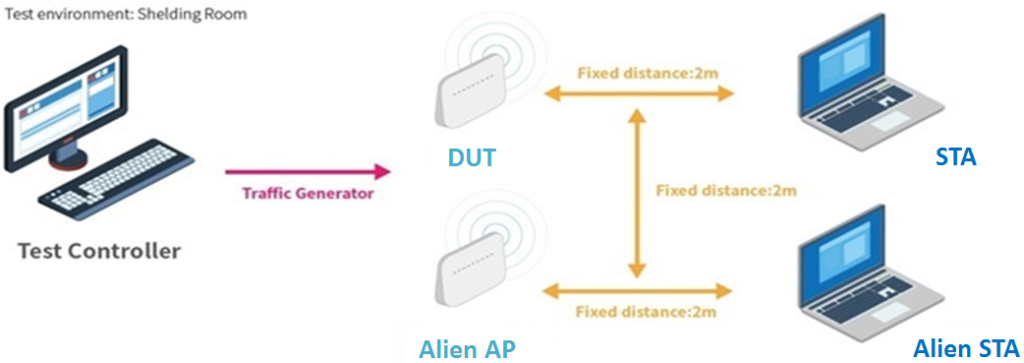Allion Labs/ Alvin Tsai & Chris Wu
TR-398 is the first industry-standard to address the Performance test of Wi-Fi APs and routers. The TR-398 standard is divided into 5 categories and we previously introduced coverage and multiple STAs performance In this article, we are going to introduce the last two test category: Stability/Robustness.
Category 5: Stability / Robustness
5-1 Long-Term Stability Test: Mandatory Test
Long term stability test intends to measure the stability performance of Wi-Fi device under stress.
Throughput and connection availability are continuously monitored in a long period of time (24 hours).

1. Downlink throughput of the Peer STAs remains stable in each frequency band with less than 20% deviation of the minimum sampling points by referring to the average throughput during the measurement of 24 hours.
2. For every hour, PER of the Ping test SHALL be less than 0.1 %.


It can be seen from the results that the packet loss and the error rate are high. Although the standard is reached, it is not meeting the requirements in the Ping test project.
5-2 AP Coexistence Test: Mandatory Test
AP coexistence test intends to verify Wi-Fi device performance with the existence of alien AP. The alien AP in the test SHALL support the same Wi-Fi standard (802.11n/802.11ac).
In addition to the relatively new technology, the performance of the wireless network is more important to avoid interference. The common interference is no more than the same frequency interference and adjacent frequency interference. The focus of this test is to simulate the AP resistance in case of external interference, whether it is possible to maintain stability and performance when disturbing.


Co-channel interference: When there are many devices in the surrounding environment that use the same channel, they will interfere with each other and reduce performance.
Adjacent-channel Interference: Because adjacent channels have a partially overlapping frequency range, the signal energy can interfere with several adjacent channels.
The average throughput measured SHALL satisfy the requirements in the table below:
| Wi-Fi Configuration (DUT) | Wi-Fi Configuration (Peer STA) | Bandwidth (MHz) | Throughput requirement referred to the No-alien-device-turn-on | ||||
| No alien device turn on | Alien AP turn on | Alien network working (same channel) | Alien network working (overlapping channel) | Alien network working (adjoining channel) | |||
| 802.11n (Nss=2) | 802.11n (Nss=2) | 20 | <5% | <60% | <60% | <5% | |
| 802.11ac (Nss=2) | 802.11ac (Nss=2) | 80 | <5% | <5% | <60% | <5% | |
This year marks the 20-year milestone of Wi-Fi. Over the course of these years, Wi-Fi has already become a necessity in our daily lives. And as Wi-Fi technology continues to evolve, new test appraoch is needed to test the APs in order to ensure the devices really meet user’s expectations. The launch of TR-398 now provides a standard for the industry to verify the performance of APs and routers. We hope that in this introduction to TR-398, you would have a better understanding of this standard.
Stay tuned to Allion tech blogs for more case studies regarding TR-398!










































